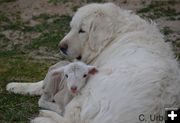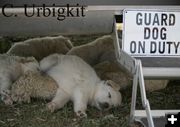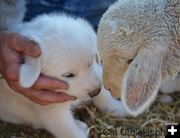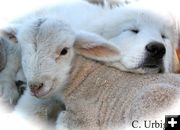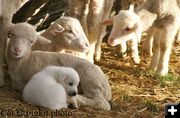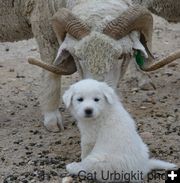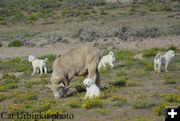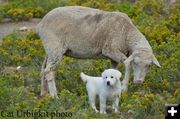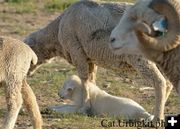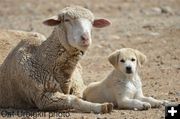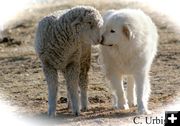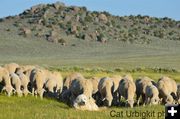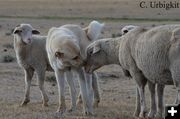
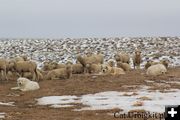
Adults
Three livestock guardian dogs with
domestic sheep. The white dogs are
Akbash (a breed from Turkey) and
the tri-colored dog is a Central
Asian Ovcharka.
|

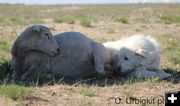
Birth
A livestock protection dog (LPD)
checks progress of a ewe beginning
labor.
|

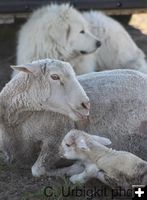
Lambing
Knowing that the ewe is at her most
vulnerable time, a livestock
protection dog (LPD) remains nearby
as the lambs are born.
|

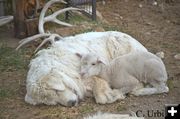
Social
Well bonded to sheep at an early
age, adult guardian dogs are
devoted to their charges.
|
|
Working Livestock Guardians
by Cat Urbigkit, Pinedale Online!
September 3, 2014
Domestic sheep producers throughout the western United States often use livestock guardian dogs to protect their flocks from predators. Hikers, hunters, and other outdoor enthusiasts may encounter the dogs and their herds while on public land. Livestock producers using public lands do not want hikers being frightened by livestock guardian dogs, so here's a few pointers on what to do if you encounter the dogs, as well as a photo essay that shows how the dogs are raised to protect their herds.
Most livestock guardian dogs used in the American West do not perceive humans as a threat to the herd that is, unless a strange human is approaching the herd. In most cases, when a strange human is encountered on the range, the guardians reaction is going to be an attempt to intimidate the intruder. That means raised hackles and tail, and loud barking as the dog rushes toward the intrusion. Ive encountered dozens (if not hundreds) of working guardian dogs in my travels here and in many countries abroad, and Ive always stood quietly, talking to the dogs until they realize Im not a threat
and go back to their sheep. I would never attempt to hike through the middle of a sheep herd I randomly encountered on the range. Skirting around the herd is appropriate.
Generally, if you are on foot, horseback, or an all-terrain vehicle and come close to sheep, a livestock protection dog should have time to see and/or hear you approach and recognize that you are not a threat to the livestock. But a rapidly approaching mountain biker, suddenly surprising the livestock protection dog, may appear to be a threat. Stop, get off the bike while keeping it between the dog and your body, and talk to the dog so it can recognize you are a human.
Hikers with domestic dogs may be perceived as a greater threat. An unleashed dog encountering sheep likely will be perceived as a predator, which could cause an aggressive confrontation with the livestock protection dog. Uncontrolled domestic dogs are the top killer of livestock in America, and a guardian dog's job is to keep these animals from harming the herd.
People hiking and biking on western rangelands are encouraged to carry pepper spray and be knowledgeable about how to use it. Pepper spray works on many animals that can be perceived as threatening from bears and mountain lions, to dogs.
In some ares of the west, federal agencies post signs for the public that warn of the presence of livestock protection dogs, describe their purpose, and provide pointers for what to do when encountering these animals with their herds. The Colorado Wool Growers Association provides the following recommendations for hikers and bikers:
DO:
Keep your dog on a leash and never allow your dog to harass the sheep
Watch for livestock protection dogs near sheep (usually large white or tan dogs)
Remain calm if a livestock protection dog approaches
Stop and get off of your bike, put your bike between you and the dog
Tell the dog to "go back to the sheep"
Walk your bike until well past the sheep
Keep your distance from the sheep
Choose the least disruptive route around the sheep
If the sheep are trailing, wait for them to pass
DO NOT:
Chase or harass the sheep or dogs
Try to outrun the dogs
Throw things at the dogs
Make quick movements
Feed the dogs
Take a dog with you
Attempt to befriend or pet the dog
Livestock guardian dogs are generally viewed as effective, non-lethal predator deterrents. Producers who use guardian dogs report far fewer losses to predators than producers who do not use guardian animals.
|



